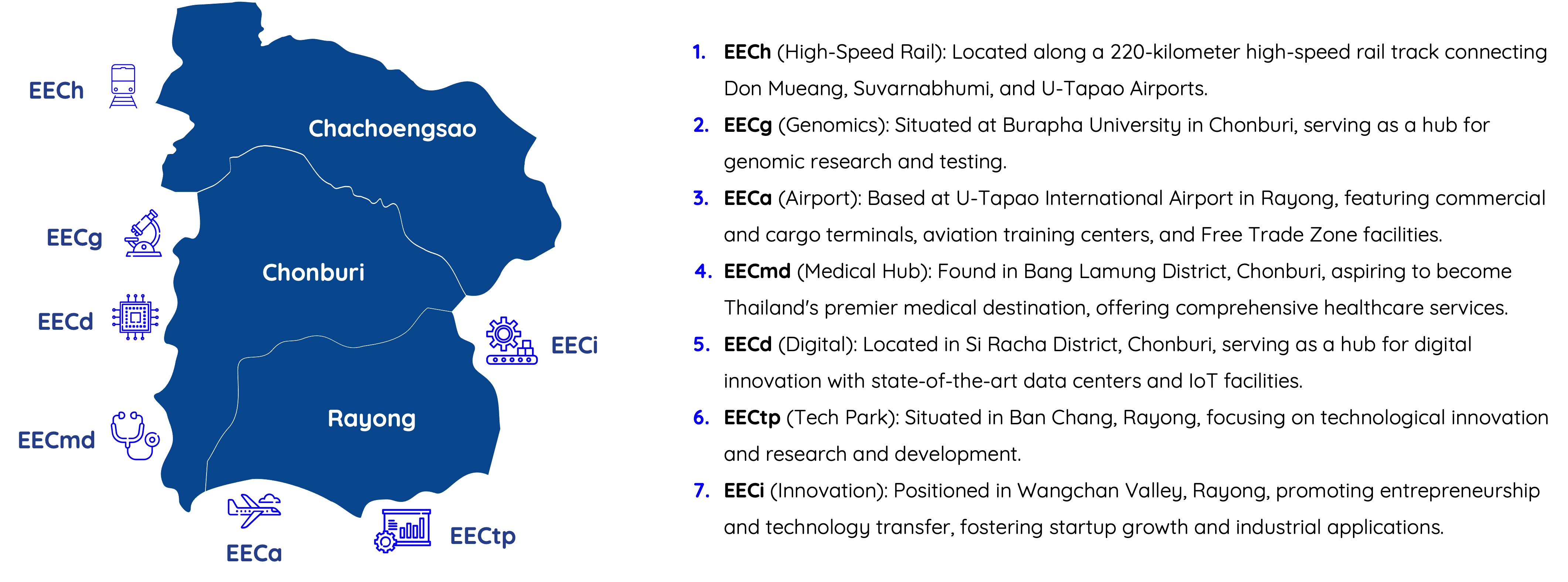In the realm of economic transformation, Thailand’s Eastern Economic Corridor (EEC) stands as a beacon of innovation and progress. Established in 2018, this visionary project aims to elevate the eastern region of Thailand into a premier economic powerhouse within the ASEAN landscape. Covering the provinces of Chachoengsao, Chonburi, and Rayong, along with the eastern portion of Nakhon Ratchasima Province, the EEC is strategically positioned to catalyze growth across diverse industries.
At its core, the EEC is built upon a foundation of targeted industry development, with a keen focus on fostering innovation, enhancing competitiveness, and promoting sustainable growth. Through strategic investment and infrastructure development, the EEC aims to attract key players in ten pivotal sectors, ranging from next-generation automotive and smart electronics to affluent medical tourism and digital innovation. By offering incentives and streamlining regulations, the Thai government is paving the way for transformative progress, positioning the EEC as a magnet for foreign direct investment (FDI) and technological advancement.

Figure 1. Business Opportunities in the Eastern Economic Corridor (EEC).
Recent developments within the EEC underscore its commitment to driving economic evolution. Expansions at Laem Chabang port and the Map Ta Phut industrial estate highlight efforts to bolster logistics capabilities and enhance connectivity, laying the groundwork for seamless trade and commerce. Moreover, initiatives such as the deployment of 5G technology and the establishment of Pluak Daeng Hospital 2 signify a concerted push towards modernization and infrastructure excellence.
One of the hallmarks of the EEC initiative is its innovative visa scheme designed to attract top-tier talent and investors. By offering long-term visas and expedited processes, the EEC aims to create a conducive environment for business growth and talent acquisition, further bolstering its competitive edge on the global stage.
In tandem with its industry-focused approach, the EEC has identified seven special economic promotional zones tailored to specific sectors. From high-speed rail corridors to genomics testing hubs and digital innovation centers, these zones serve as incubators for cutting-edge research, development, and commercialization, driving progress across key industries.
1. One such zone is EECh (High-Speed Rail), spanning 220 kilometers along the high-speed rail track connecting Don Mueang, Suvarnabhumi, and U-Tapao Airports. EECh aims to revolutionize regional transportation infrastructure, enhancing connectivity and bolstering economic activity.
2. Another prominent zone, EECg (Genomics), situated at Burapha University in Chonburi, serves as a hub for genomic research and testing. Leveraging Next-Generation Sequencing Technology, EECg drives advancements in medicine and biotechnology, fostering collaboration and innovation.
3. EECa (Airport), located at U-Tapao International Airport in Rayong, boasts extensive business facilities, including commercial and cargo terminals and aviation training centers. This zone aims to elevate Thailand’s aviation industry, facilitating global trade and connectivity.
4. In the healthcare sector, EECmd (Medical Hub) in Bang Lamung District, Chonburi, strives to become Thailand’s leading medical destination, offering comprehensive healthcare services and fostering medical innovation.
5. EECd (Digital) in Si Racha District, Chonburi, serves as a hub for digital innovation, featuring cutting-edge data centers and IoT facilities to drive technological advancements.
6. EECtp (Tech Park) in Ban Chang, Rayong, focuses on technological innovation, fostering research and development in emerging technologies.
7. Lastly, EECi (Innovation) in Wangchan Valley, Rayong, promotes entrepreneurship and technology transfer, nurturing startups and facilitating the transformation of research into industrial applications.
These specialized zones underscore the EEC’s commitment to driving economic growth and innovation in Thailand, positioning the nation as a regional leader in key industries.

Figure 2. Exploring the Seven Specialized Economic Zones of the Eastern Economic Corridor (EEC)
Amidst the backdrop of global economic shifts, the EEC emerges as a beacon of opportunity and resilience. As companies seek alternatives to navigate the uncertainties of the US-China trade war, Thailand’s strategic location and forward-thinking policies position it as an attractive destination for investment and expansion. By leveraging the EEC’s vast potential, Thailand is not only diversifying its economy but also future-proofing its growth trajectory in the face of evolving geopolitical dynamics.
In conclusion, the Eastern Economic Corridor represents a transformative force poised to reshape Thailand’s economic landscape for decades to come. Through strategic investment, targeted industry development, and forward-looking policies, the EEC is charting a path towards sustainable growth, innovation, and prosperity. As Thailand embraces its role as a regional economic powerhouse, the EEC stands as a testament to the nation’s unwavering commitment to progress and prosperity.